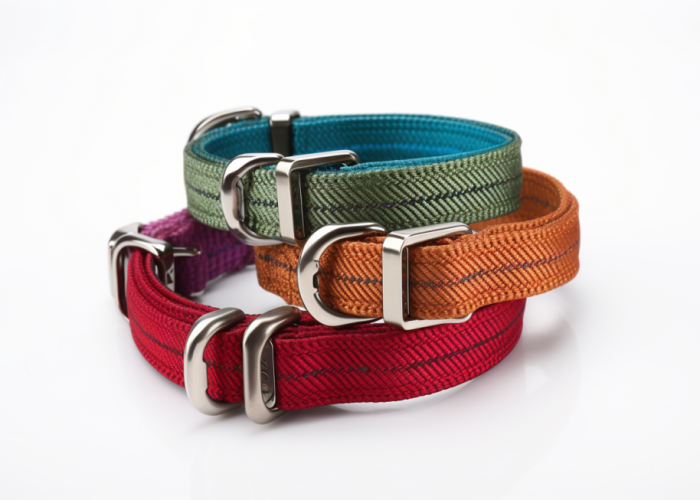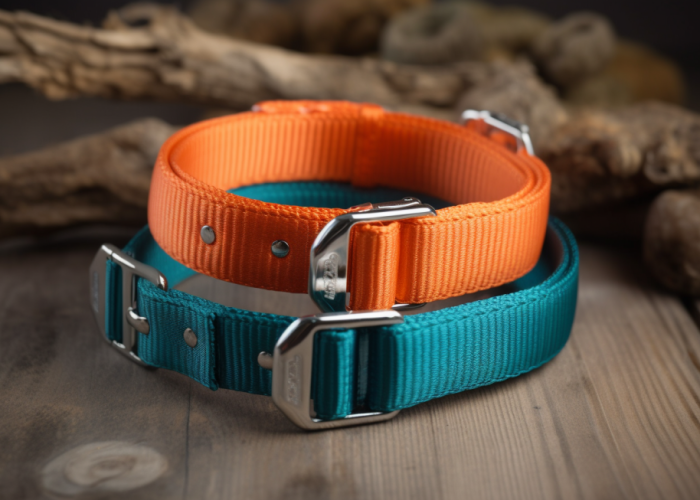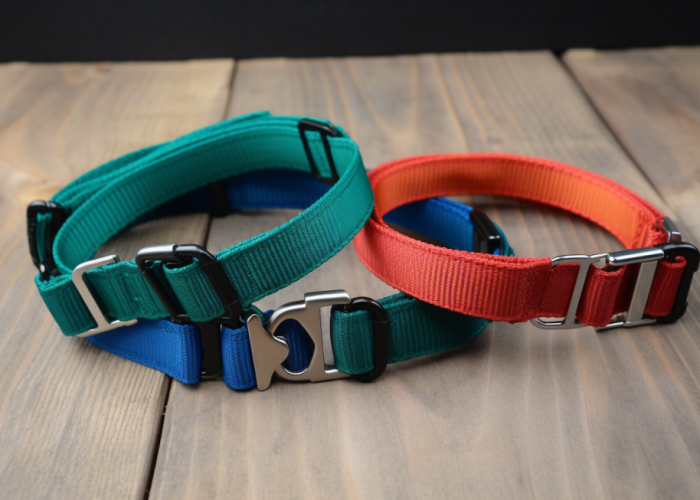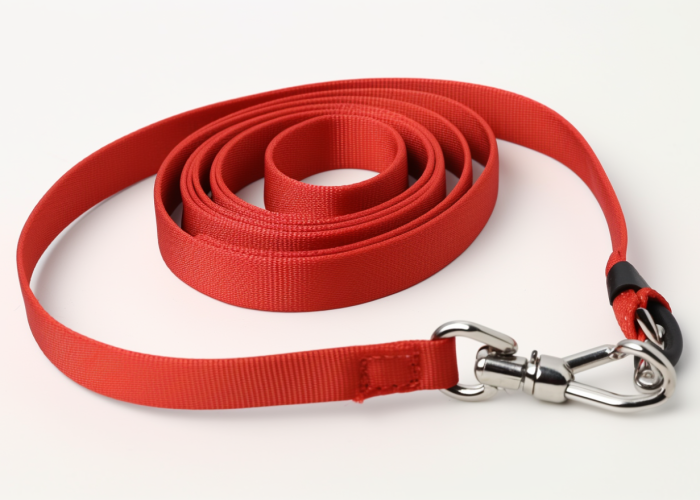As a custom webbing manufacturer specializing in tailor-made solutions for pet product brands, we frequently receive inquiries about flat nylon webbing customization for collar applications. This post addresses the key questions product developers and brand manufacturers ask when selecting and specifying nylon webbing for their pet collar designs. We offer comprehensive customization services including solution dyeing, printing, pattern creation, hardware integration, and engineering consultation to help optimize your product performance and manufacturing efficiency.
Yes, flat nylon webbing can be extensively customized for pet collars through color options, printing, pattern creation, and hardware integration while maintaining durability and safety standards.
Discover the best customization options for pet collars with technical insights on nylon webbing to balance performance, aesthetics, and cost.


Webbing manufacturing expert with 15+ years of experience helping product developers build high-performance straps for industrial, medical, and outdoor use.
Flat nylon webbing delivers superior abrasion resistance and moisture performance compared to cotton or polyester alternatives, making it the preferred choice for durable pet collar applications.
Key Performance Specifications:
Nylon webbing demonstrates three times the outdoor lifespan of cotton alternatives and absorbs 90% less moisture. Cotton webbing shows visible wear within 200-300 wash cycles, while nylon maintains integrity beyond 1,000 cycles. Polyester performs better than cotton but lacks nylon’s abrasion tolerance in high-wear areas like buckle contact points.
From our manufacturing experience, cotton-based collars frequently fail within 6-8 months due to fraying and weakened attachment points. Nylon webbing collars maintain functionality for 2-3 years under identical conditions. One premium pet brand reduced return rates from 15% to under 3% by switching from cotton to nylon webbing.
OEKO-TEX® Standard 100 certification ensures nylon’s chemical safety for pet contact, while REACH compliance addresses European market requirements. Nylon’s natural resistance to microbial growth also provides hygiene advantages over cotton alternatives.
Design Takeaway: Choose flat nylon webbing when product longevity and durability outweigh initial material cost considerations. Nylon provides superior value through extended service life and reduced warranty claims compared to cotton alternatives.

For optimal comfort and safety, use ¾” width for small dogs under 25 lbs, 1″ width for medium dogs 25-60 lbs, and 1.5″ width for large breeds over 60 lbs.
Width Selection Guidelines:
Proper width selection balances comfort with functionality. Narrow webbing concentrates pressure on smaller neck areas, potentially causing discomfort during pulling. Oversized webbing creates bulk and reduces collar effectiveness. 1″ width handles 80% of medium dog applications effectively while maintaining comfortable contact pressure without overwhelming smaller neck circumferences.
Customer feedback from dog trainers shows comfort issues when width doesn’t match dog size appropriately. Small dogs with oversized collars experience restricted movement and difficulty with proper fit adjustment. Large dogs with narrow webbing show neck irritation from concentrated pressure points. A professional dog training facility reported improved training results when implementing breed-appropriate width specifications across their collar inventory.
Pet industry sizing recommendations provide guidance for width-to-weight ratios in collar design applications.
Design Takeaway: Create size-specific product lines rather than universal sizing approaches. Width selection directly impacts customer satisfaction and collar functionality – consider width optimization consultation for breed-specific applications.
Solution-dyed colors provide the best fade resistance for outdoor use, while sublimation printing offers design flexibility with good durability, and screen printing works for simple designs with moderate longevity.
Color Method Durability Rankings:
Solution dyeing integrates color during fiber production, creating permanent color that won’t fade or wash out. Sublimation printing allows photographic-quality images and gradient effects while maintaining good outdoor performance. Screen printing offers the most economical option for solid colors and basic patterns but shows faster deterioration in direct sunlight exposure.
Field performance varies significantly by method. An outdoor gear manufacturer discovered dramatic customer satisfaction improvements after switching from screen printing to solution-dyed webbing. Products that previously showed noticeable fading within one season maintained vibrant appearance throughout multiple years of heavy outdoor use. Regional testing confirms solution-dyed colors lasting significantly longer in high-UV environments.
Color fastness testing ensures reliable fade resistance verification for outdoor applications.
Design Takeaway: Specify solution dyeing for premium outdoor products despite moderate cost increase. Sublimation printing ideal for products requiring design complexity with good durability. Screen printing suitable for indoor applications or budget-conscious products with shorter service expectations.

Light printing coverage has minimal strength impact (2-5% reduction), while heavy ink applications can reduce performance by 10-15%, requiring design considerations for safety-critical applications.
Printing Performance Impact:
Printing processes add material layers that can create stress concentration points under load. Sublimation printing penetrates fibers without significantly altering webbing flexibility, while screen printing deposits surface layers that may crack under repeated bending. Heavy ink coverage restricts fiber movement and creates rigid sections prone to failure initiation.
Performance testing shows printed areas typically exhibit reduced flex life compared to unprinted sections. Strategic ink placement and proper application techniques help minimize strength impact. A pet leash manufacturer redesigned their printing layout after experiencing premature failures in heavily printed areas, moving decorative elements away from high-stress zones with excellent results.
Post-print testing verification ensures printed materials meet safety requirements for intended applications.
Design Takeaway: Avoid printing in high-stress areas – keep hardware attachment points and flex zones unprinted. For safety-critical applications, specify sublimation printing or conduct strength verification testing. Strategic design placement maintains visual appeal while preserving structural performance.
UV stabilization is essential for outdoor products with expected service life exceeding one year, adding moderate investment but preventing premature failure and customer dissatisfaction.
UV Protection Performance:
UV stabilization protects nylon fibers from photodegradation that causes brittleness and strength loss. Standard nylon becomes brittle and weak when exposed to continuous sunlight, while UV-stabilized versions maintain flexibility and strength for extended periods. Regional climate factors significantly impact degradation rates – desert and tropical environments accelerate UV damage compared to temperate climates.
Real-world performance data shows dramatic differences in product longevity. A dog park equipment supplier experienced frequent replacement requests for unstabilized webbing components within 12-18 months. After switching to UV-stabilized materials, replacement frequency dropped to less than 5% over three-year periods. Customer satisfaction improved significantly due to reduced product failures.
Outdoor product applications require consideration of UV exposure levels and expected service life when specifying materials.
Design Takeaway: UV stabilization investment is minimal compared to warranty claims and customer dissatisfaction from premature failures. Choose UV-stabilized nylon for any outdoor application with expected service life beyond 18 months. Long-term value analysis favors stabilization for premium positioning.

Recycled nylon maintains sufficient strength for standard pet collar applications while supporting sustainability goals, though virgin material remains preferred for heavy-duty uses.
Recycled vs. Virgin Nylon Performance:
Recycled nylon content comes primarily from post-consumer bottles and textile waste, maintaining good performance characteristics while reducing environmental impact. Quality recycled nylon performs well in most pet collar applications except extreme heavy-duty restraint systems. Processing techniques ensure recycled content meets safety and performance standards for pet contact applications.
Market research indicates growing consumer preference for sustainable materials among environmentally conscious pet owners. Brand differentiation through eco-friendly positioning resonates strongly with target demographics seeking responsible purchasing options. Environmental messaging combined with performance assurance creates compelling value proposition for conscious consumers.
Global Recycled Standard (GRS) certification verifies recycled content authenticity and supply chain responsibility.
Design Takeaway: Recycled nylon appropriate for standard pet collar applications while supporting brand sustainability initiatives. Reserve virgin nylon for working dog equipment requiring maximum strength performance. Emphasize environmental benefits as brand differentiation without compromising quality expectations.
Hardware integration during manufacturing provides stronger attachment and streamlined assembly compared to post-production methods, with multiple attachment options available.
Integration Methods Available:
Manufacturing integration offers superior attachment strength compared to field assembly methods. Proper edge finishing prevents fraying and maintains professional appearance. Quality control during production ensures consistent attachment strength and eliminates assembly variables that can cause failures.
Operational efficiency analysis from manufacturing partners shows significant assembly improvements with integrated hardware. Reduced handling steps minimize defect opportunities and streamline quality control processes. Automated integration processes provide consistent results compared to manual assembly operations.
Hardware integration requires coordination between webbing and hardware specifications during design phase.
Design Takeaway: Plan hardware integration early in design process for optimal strength and efficiency. Manufacturing integration provides better quality control than post-assembly methods. Early specification coordination optimizes hardware integration timing and manufacturing effectiveness.
Plan 3-4 weeks for standard customization with 4-6 weeks for complex specifications, considering minimum order quantities and seasonal demand factors.
Planning Timeline Factors:
Minimum order quantities influence both pricing structure and production scheduling, with larger volumes providing economies of scale and priority allocation. Seasonal demand patterns, particularly spring pet product launches, can extend standard lead times. Strategic planning prevents delays and ensures capacity availability during peak periods.
Supply chain management improves through proactive communication about specifications and timing requirements. Successful product launches benefit from adequate lead time planning that allows flexibility for specification refinements and quality verification without schedule constraints.
Quality verification processes add time to production schedules but ensure specification compliance before shipment.
Design Takeaway: Initiate planning discussions early in product development for accurate timing and capacity coordination. Build in verification time for specification adjustments and quality confirmation. Advance planning provides optimal results compared to compressed scheduling that limits optimization opportunities.

Flat nylon webbing offers excellent customization flexibility for pet collar applications while maintaining durability and safety standards. Solution dyeing and proper width selection optimize performance for specific requirements. UV stabilization ensures longevity for outdoor products. Contact us to explore manufacturing solutions tailored to your pet collar product requirements.
Yes, we provide color matching services using Pantone references or physical samples. Solution dyeing offers the most accurate color matching with excellent consistency across production runs. Color matching typically adds 1-2 weeks to standard lead times for sample approval.
Sample yardage available for all custom specifications at nominal cost. Samples include your exact color, width, and printing specifications for evaluation before committing to production quantities. Sample lead time is typically 5-7 business days.
Yes, we coordinate direct shipping to your manufacturing partners or assembly facilities worldwide. Packaging can be customized for your production requirements, including specific roll lengths, labeling, and delivery scheduling to support your assembly timeline and inventory management needs.
We conduct tensile strength testing, color fastness verification, and dimensional accuracy checks on all custom orders. Additional testing for UV resistance, abrasion performance, or chemical compliance available upon request. Test certificates provided with shipments for quality documentation.
Minimum orders typically start at 500-1,000 yards depending on customization complexity. Standard colors and widths require lower minimums, while custom dyeing, printing, or specialized specifications need higher quantities to justify setup costs. Volume pricing provides better per-yard rates for larger orders.
Custom nylon webbing typically costs 20-40% more than standard inventory items. Solution dyeing adds 15-20%, printing adds 25-35%, and UV stabilization increases cost by 12-15%. Volume discounts and simplified specifications help optimize pricing for budget-conscious projects.